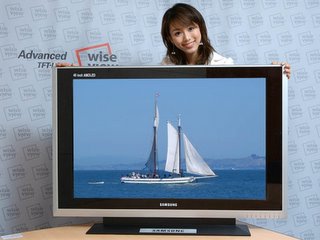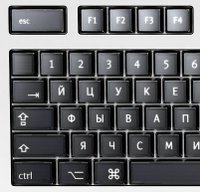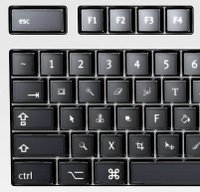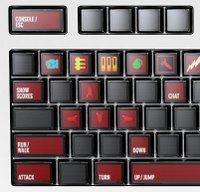Dynamic Keyboard
Introduction
Art Lebedev, a Russian design firm, has recently created a concept keyboard intent on changing the way we type. No, it’s not super ergonomically correct or specially designed for your figures. From first glance it just looks like your average everyday keyboard with an extra mini-keypad on the left.
Art Lebedev, a Russian design firm, has recently created a concept keyboard intent on changing the way we type. No, it’s not super ergonomically correct or specially designed for your figures. From first glance it just looks like your average everyday keyboard with an extra mini-keypad on the left.
On closure examination, they keyboard reveals its true secrets. Each key has an OLED covering which can change dynamically. The development is obvious, yet genius. Imagine a keyboard that can change its keys depending on what program you are using, or what language you are in. The “Optimus Keyboard” plans to make that dream become reality.
OLED?
That’s right: organic light-emitting diodes. The technology has been in development for sometime and is expected to replace standard LEDs and LCDs in due time. The technology behind the OLEDs is more than I want to go into, but it isi basically a thin strip of material that can emit light and does so with little power requisites because it is an organic compound at the core of the “fabric” or screen that emits the light. The biggest problem with the OLEDs is that they have a certain shelf-life because they are organic. The red and green have been made to work for 20,000 hours, but there are still troubles with the blue OLEDs. Kodak does allege to have made blue OLEDs with a life of 100,000 hours, but such are not easy accessible as of now.
 The biggest advantage organic LEDs have over standard LEDs, LCDs and projection screens is that they do not need a backlight and thus are much more energy efficient. Also, the OLEDs can be made more flexible and thinner than other materials. The technology is not in complete infancy, and although I have not come across any spectacular commercial products that already harness the OLED technology many prototype products have been made. The Samsung TV seen above is an 40 inch OLED prototype from the company.
The biggest advantage organic LEDs have over standard LEDs, LCDs and projection screens is that they do not need a backlight and thus are much more energy efficient. Also, the OLEDs can be made more flexible and thinner than other materials. The technology is not in complete infancy, and although I have not come across any spectacular commercial products that already harness the OLED technology many prototype products have been made. The Samsung TV seen above is an 40 inch OLED prototype from the company.
The new technology has a lot of potential and is a good tool to look into for developers.
 Language Variations
Language Variations
With the new keyboard from Artemy Lebedev we will be able to switch quickly between different languages. If you are a person that is fluent (or needs to type) in more than one language then this would be a very effective tool for you. The different keyboard settings come in useful if your languages have a different alphabet (like Russian and English).
The ability to easily switch languages would not only be convineint but make a wonderful culture preservative. Now people from different cultures will not have to make up ways to write their tongue with English script, just because they do not remember the layout of their native keyboard.

 Application Variations
Application Variations
Since the OLEDs are dynamic and quick to respond, the buttons on your keyboard could change from application to application and inside an application. The examples on the right show the layout for Photoshop and Quake. Such a dynamically changing tool would allow computer game developers some new creative grounds and would make gaming and application shortcuts somewhat more natural. You could click the control key and suddenly “s” would change into a little save disk and “c” into a pair of scissors. If you hit the windows key the letter “l” would now read “switch users”. I think such a tool would be a very good tool for making applications, operating systems and gam es more intuitive.
es more intuitive.
When it is all said and done
The keyboard is said to release in 2006, but I believe that is a very optimistic date of release. The company might manage to make an LED or LCD version of their keyboard, but a full OLED keyboard might be hard. The developing company claims:
As of now, the patent is still pending on the keyboard and it is still in “initial stages of production.” I am afraid we will not see the keyboard come out in 2006, but the idea is out of the closet and I am sure we can see something like this tool on the market in the near future.
The biggest problem with the Optimus keyboard is if we really need it. The keyboard might just be too little too late. The market is moving towards smaller and smaller keyboards and searching for other input devices. I am afraid the new dynamically changing keyboard will not see the same sort of fame our current keyboard sees.
Conclusion
The idea might be an obvious one, the technology might not be complete and the company might not make the best mass producer. The main point of this product, however, is that it exists. The word is out there and hopefully one day we will see a dynamically changing keyboard.
OLED?
That’s right: organic light-emitting diodes. The technology has been in development for sometime and is expected to replace standard LEDs and LCDs in due time. The technology behind the OLEDs is more than I want to go into, but it isi basically a thin strip of material that can emit light and does so with little power requisites because it is an organic compound at the core of the “fabric” or screen that emits the light. The biggest problem with the OLEDs is that they have a certain shelf-life because they are organic. The red and green have been made to work for 20,000 hours, but there are still troubles with the blue OLEDs. Kodak does allege to have made blue OLEDs with a life of 100,000 hours, but such are not easy accessible as of now.
 The biggest advantage organic LEDs have over standard LEDs, LCDs and projection screens is that they do not need a backlight and thus are much more energy efficient. Also, the OLEDs can be made more flexible and thinner than other materials. The technology is not in complete infancy, and although I have not come across any spectacular commercial products that already harness the OLED technology many prototype products have been made. The Samsung TV seen above is an 40 inch OLED prototype from the company.
The biggest advantage organic LEDs have over standard LEDs, LCDs and projection screens is that they do not need a backlight and thus are much more energy efficient. Also, the OLEDs can be made more flexible and thinner than other materials. The technology is not in complete infancy, and although I have not come across any spectacular commercial products that already harness the OLED technology many prototype products have been made. The Samsung TV seen above is an 40 inch OLED prototype from the company.The new technology has a lot of potential and is a good tool to look into for developers.
 Language Variations
Language VariationsWith the new keyboard from Artemy Lebedev we will be able to switch quickly between different languages. If you are a person that is fluent (or needs to type) in more than one language then this would be a very effective tool for you. The different keyboard settings come in useful if your languages have a different alphabet (like Russian and English).
The ability to easily switch languages would not only be convineint but make a wonderful culture preservative. Now people from different cultures will not have to make up ways to write their tongue with English script, just because they do not remember the layout of their native keyboard.

 Application Variations
Application VariationsSince the OLEDs are dynamic and quick to respond, the buttons on your keyboard could change from application to application and inside an application. The examples on the right show the layout for Photoshop and Quake. Such a dynamically changing tool would allow computer game developers some new creative grounds and would make gaming and application shortcuts somewhat more natural. You could click the control key and suddenly “s” would change into a little save disk and “c” into a pair of scissors. If you hit the windows key the letter “l” would now read “switch users”. I think such a tool would be a very good tool for making applications, operating systems and gam
 es more intuitive.
es more intuitive.When it is all said and done
The keyboard is said to release in 2006, but I believe that is a very optimistic date of release. The company might manage to make an LED or LCD version of their keyboard, but a full OLED keyboard might be hard. The developing company claims:
It’s in the initial stage of production.
We hope it will be released in 2006.
It will cost less than a good mobile phone.
It will be real.
It will be OS-independent (at least it’s going to be able to work in some default state with any OS).
It will support any language or layout.
As of now, the patent is still pending on the keyboard and it is still in “initial stages of production.” I am afraid we will not see the keyboard come out in 2006, but the idea is out of the closet and I am sure we can see something like this tool on the market in the near future.
The biggest problem with the Optimus keyboard is if we really need it. The keyboard might just be too little too late. The market is moving towards smaller and smaller keyboards and searching for other input devices. I am afraid the new dynamically changing keyboard will not see the same sort of fame our current keyboard sees.
Conclusion
The idea might be an obvious one, the technology might not be complete and the company might not make the best mass producer. The main point of this product, however, is that it exists. The word is out there and hopefully one day we will see a dynamically changing keyboard.
Labels: technology























2 Comments:
"and although I have not come across any spectacular commercial products that already harness the OLED technology"
Just to let you know, alot of Sony flash mp3 players and that cube mp3 player use OLED's as their screen.
I'd love this thing; it's not too hard to type Swedish characters on my keyboard, but when I'm typing with only one hand (reading a book and typing in a word in the Swedish/English dictionary,) it does get a bit tedious and slow. And given how slow I'm reading this book (I'm done the first chapter after 2 months,) maybe it'll be released before I'm done :)
Post a Comment
<< Home